Teamwork Report: Approaches, Dynamics, and Personal Contributions
VerifiedAdded on 2020/09/17
|10
|2186
|471
Report
AI Summary
This report delves into the multifaceted concept of teamwork, emphasizing its significance in achieving organizational goals. It explores various teamwork approaches, including the theories of Bruce Tuckman and Belbin, highlighting their roles in team formation, dynamics, and individual contributions. The report analyzes the characteristics of effective teams, such as unified goals, participation, and decision-making processes, and discusses the importance of managing team dynamics through communication, motivation, and conflict resolution. Furthermore, it examines the stages of team development according to Tuckman's model and the different roles within a team as defined by Belbin, emphasizing how these frameworks can be applied to enhance team performance and achieve desired outcomes. The report concludes by underscoring the essential role of teamwork in the contemporary business environment and provides recommendations for implementing the discussed approaches to foster a collaborative and productive work environment.
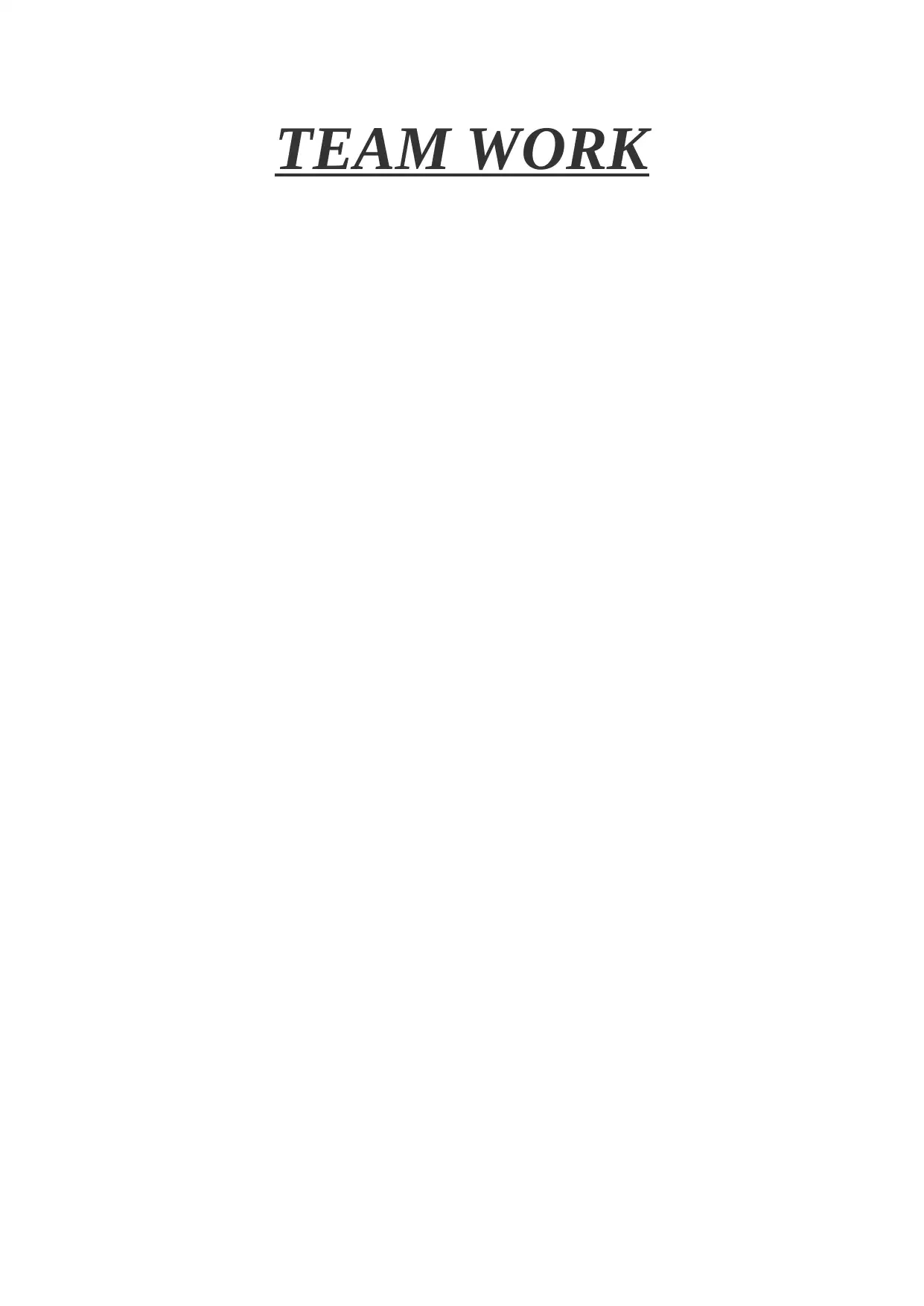
TEAM WORK
Paraphrase This Document
Need a fresh take? Get an instant paraphrase of this document with our AI Paraphraser
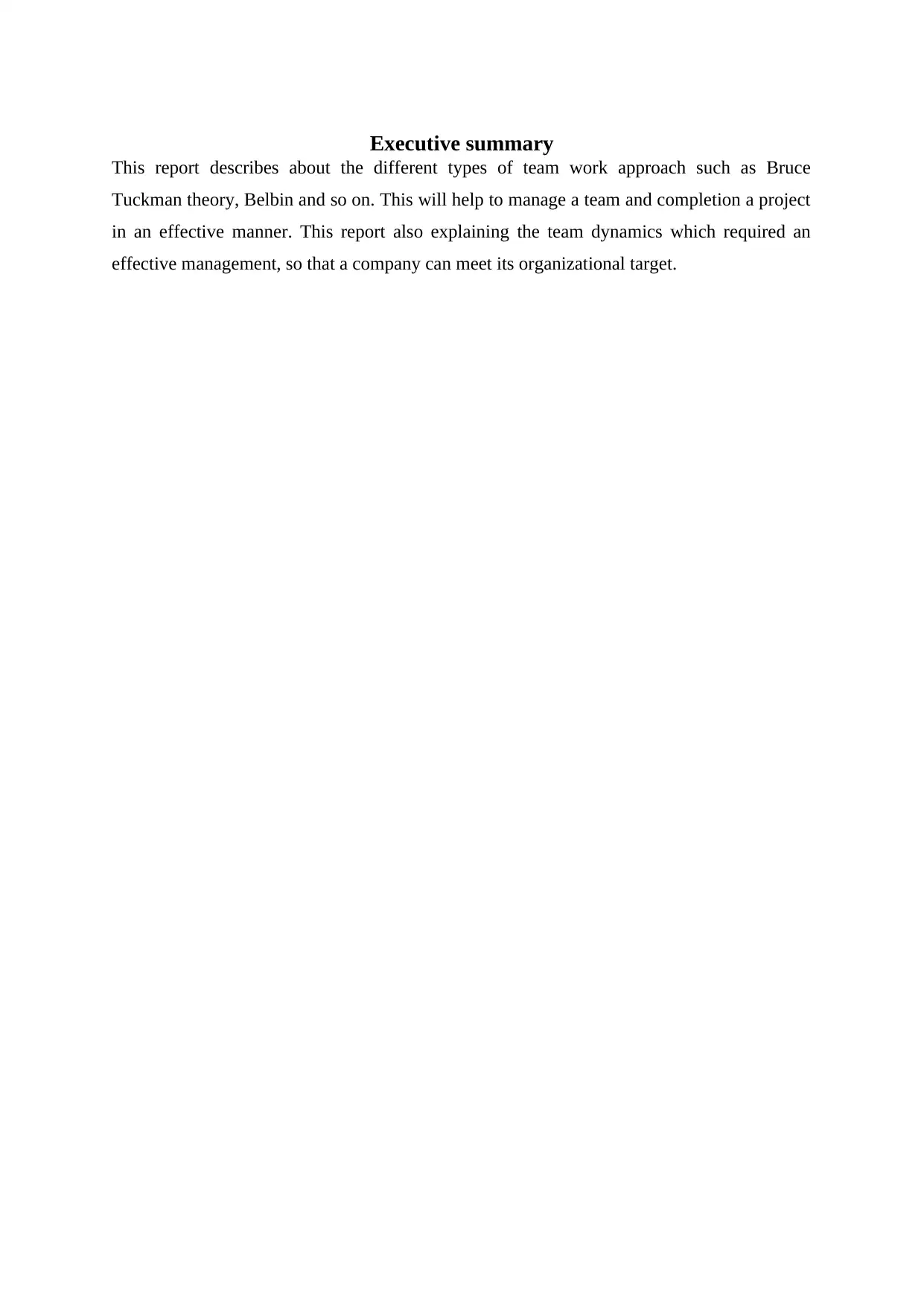
Executive summary
This report describes about the different types of team work approach such as Bruce
Tuckman theory, Belbin and so on. This will help to manage a team and completion a project
in an effective manner. This report also explaining the team dynamics which required an
effective management, so that a company can meet its organizational target.
This report describes about the different types of team work approach such as Bruce
Tuckman theory, Belbin and so on. This will help to manage a team and completion a project
in an effective manner. This report also explaining the team dynamics which required an
effective management, so that a company can meet its organizational target.
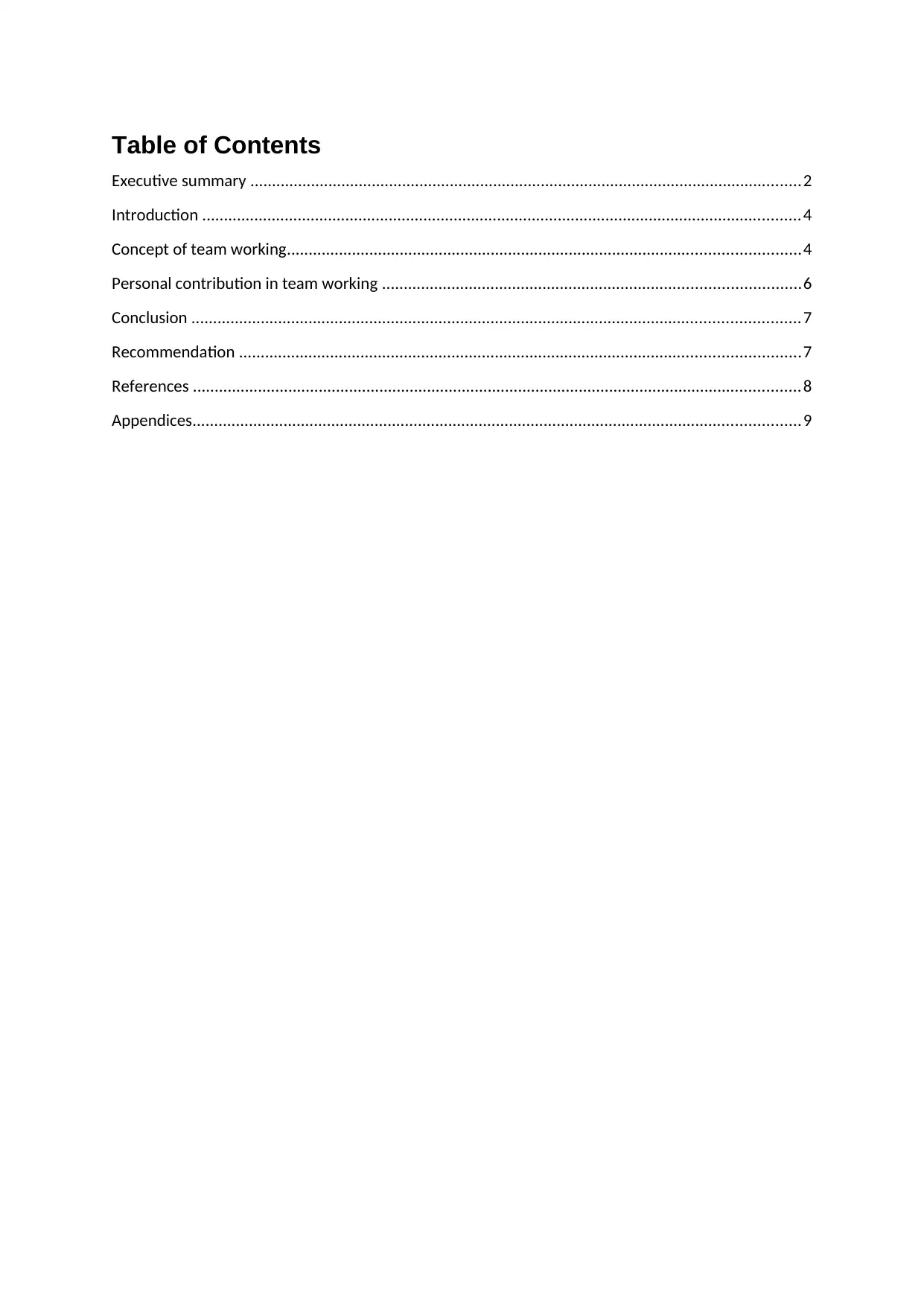
Table of Contents
Executive summary ...............................................................................................................................2
Introduction ..........................................................................................................................................4
Concept of team working......................................................................................................................4
Personal contribution in team working ................................................................................................6
Conclusion ............................................................................................................................................7
Recommendation .................................................................................................................................7
References ............................................................................................................................................8
Appendices............................................................................................................................................9
Executive summary ...............................................................................................................................2
Introduction ..........................................................................................................................................4
Concept of team working......................................................................................................................4
Personal contribution in team working ................................................................................................6
Conclusion ............................................................................................................................................7
Recommendation .................................................................................................................................7
References ............................................................................................................................................8
Appendices............................................................................................................................................9
⊘ This is a preview!⊘
Do you want full access?
Subscribe today to unlock all pages.

Trusted by 1+ million students worldwide
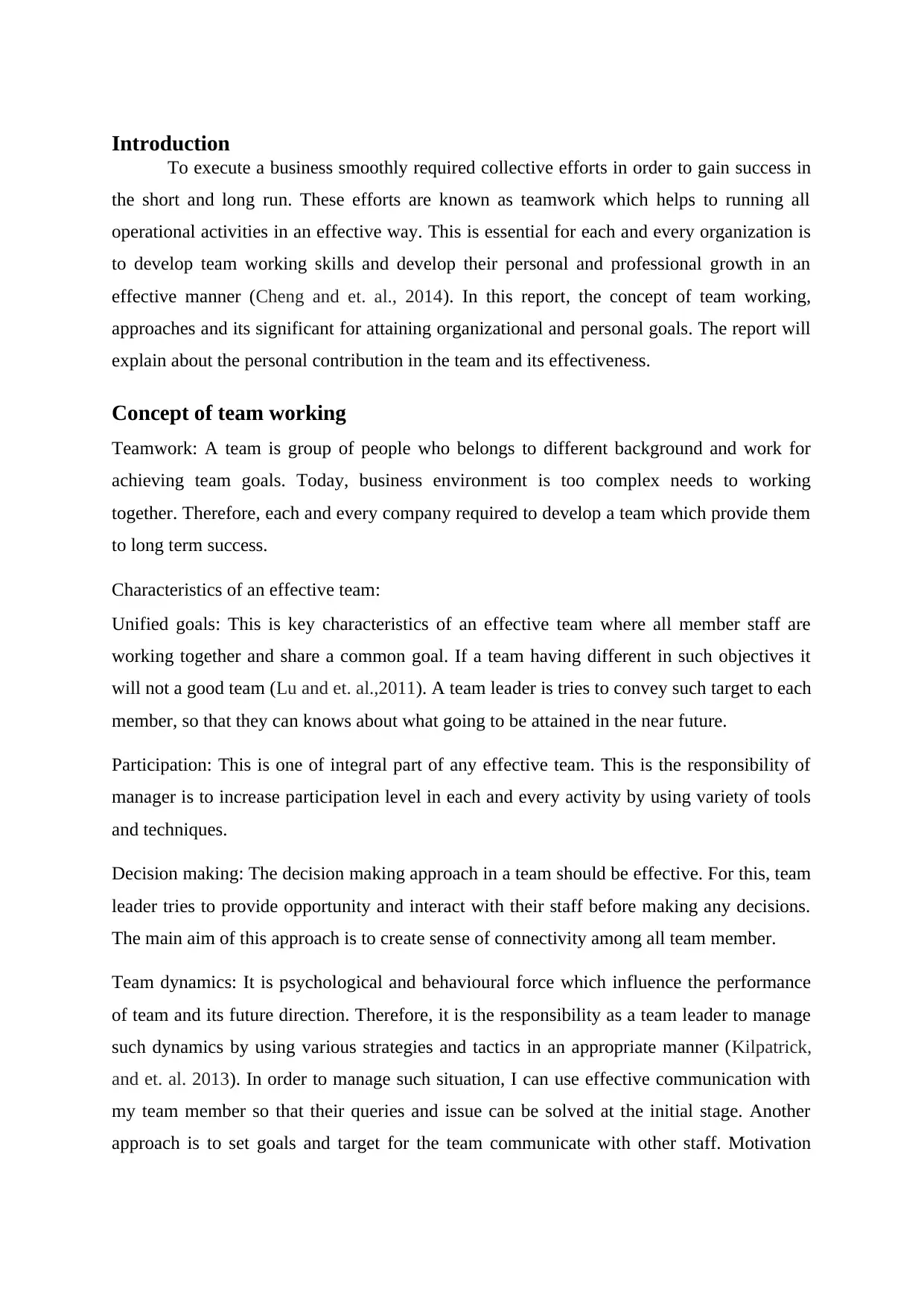
Introduction
To execute a business smoothly required collective efforts in order to gain success in
the short and long run. These efforts are known as teamwork which helps to running all
operational activities in an effective way. This is essential for each and every organization is
to develop team working skills and develop their personal and professional growth in an
effective manner (Cheng and et. al., 2014). In this report, the concept of team working,
approaches and its significant for attaining organizational and personal goals. The report will
explain about the personal contribution in the team and its effectiveness.
Concept of team working
Teamwork: A team is group of people who belongs to different background and work for
achieving team goals. Today, business environment is too complex needs to working
together. Therefore, each and every company required to develop a team which provide them
to long term success.
Characteristics of an effective team:
Unified goals: This is key characteristics of an effective team where all member staff are
working together and share a common goal. If a team having different in such objectives it
will not a good team (Lu and et. al.,2011). A team leader is tries to convey such target to each
member, so that they can knows about what going to be attained in the near future.
Participation: This is one of integral part of any effective team. This is the responsibility of
manager is to increase participation level in each and every activity by using variety of tools
and techniques.
Decision making: The decision making approach in a team should be effective. For this, team
leader tries to provide opportunity and interact with their staff before making any decisions.
The main aim of this approach is to create sense of connectivity among all team member.
Team dynamics: It is psychological and behavioural force which influence the performance
of team and its future direction. Therefore, it is the responsibility as a team leader to manage
such dynamics by using various strategies and tactics in an appropriate manner (Kilpatrick,
and et. al. 2013). In order to manage such situation, I can use effective communication with
my team member so that their queries and issue can be solved at the initial stage. Another
approach is to set goals and target for the team communicate with other staff. Motivation
To execute a business smoothly required collective efforts in order to gain success in
the short and long run. These efforts are known as teamwork which helps to running all
operational activities in an effective way. This is essential for each and every organization is
to develop team working skills and develop their personal and professional growth in an
effective manner (Cheng and et. al., 2014). In this report, the concept of team working,
approaches and its significant for attaining organizational and personal goals. The report will
explain about the personal contribution in the team and its effectiveness.
Concept of team working
Teamwork: A team is group of people who belongs to different background and work for
achieving team goals. Today, business environment is too complex needs to working
together. Therefore, each and every company required to develop a team which provide them
to long term success.
Characteristics of an effective team:
Unified goals: This is key characteristics of an effective team where all member staff are
working together and share a common goal. If a team having different in such objectives it
will not a good team (Lu and et. al.,2011). A team leader is tries to convey such target to each
member, so that they can knows about what going to be attained in the near future.
Participation: This is one of integral part of any effective team. This is the responsibility of
manager is to increase participation level in each and every activity by using variety of tools
and techniques.
Decision making: The decision making approach in a team should be effective. For this, team
leader tries to provide opportunity and interact with their staff before making any decisions.
The main aim of this approach is to create sense of connectivity among all team member.
Team dynamics: It is psychological and behavioural force which influence the performance
of team and its future direction. Therefore, it is the responsibility as a team leader to manage
such dynamics by using various strategies and tactics in an appropriate manner (Kilpatrick,
and et. al. 2013). In order to manage such situation, I can use effective communication with
my team member so that their queries and issue can be solved at the initial stage. Another
approach is to set goals and target for the team communicate with other staff. Motivation
Paraphrase This Document
Need a fresh take? Get an instant paraphrase of this document with our AI Paraphraser
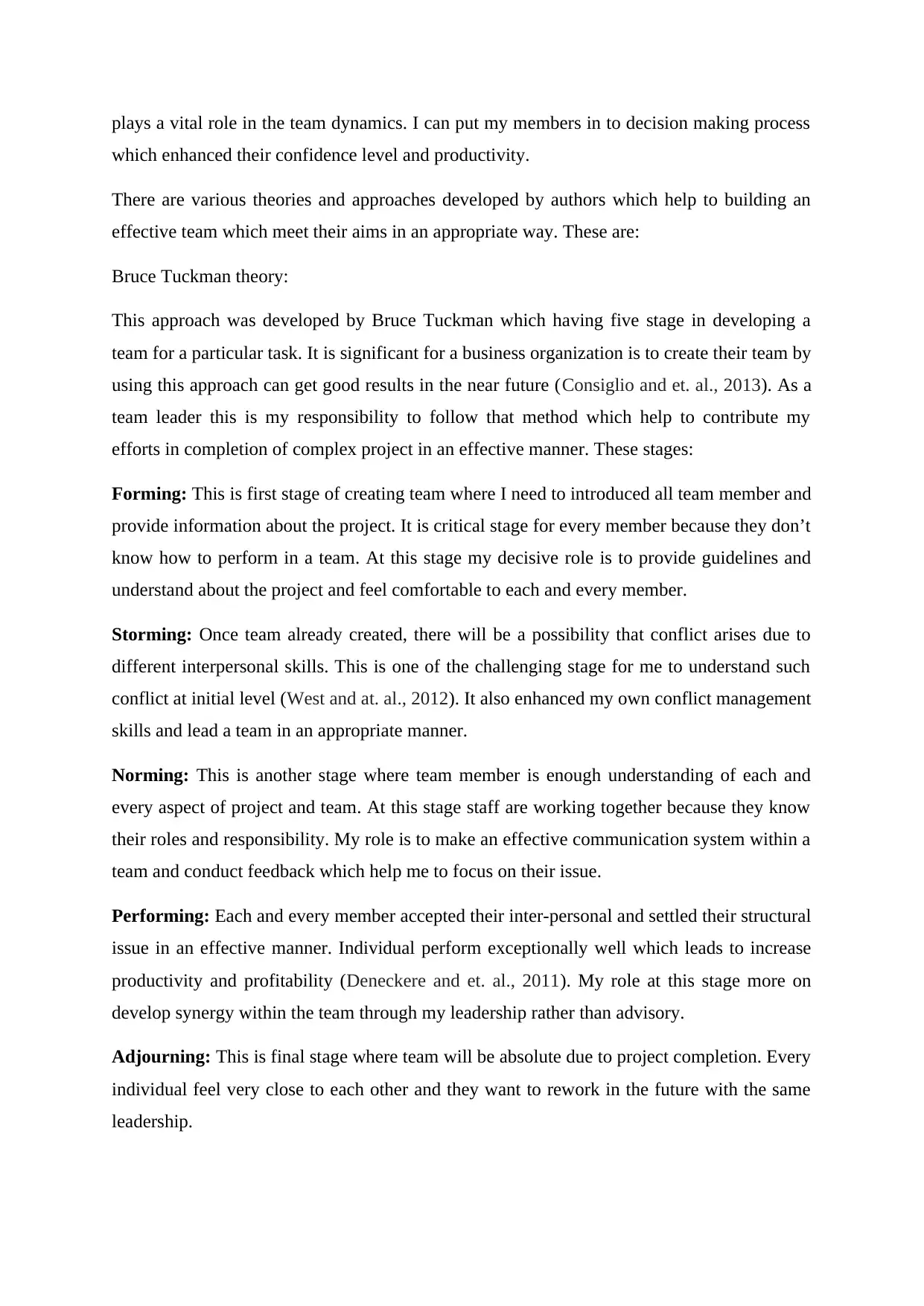
plays a vital role in the team dynamics. I can put my members in to decision making process
which enhanced their confidence level and productivity.
There are various theories and approaches developed by authors which help to building an
effective team which meet their aims in an appropriate way. These are:
Bruce Tuckman theory:
This approach was developed by Bruce Tuckman which having five stage in developing a
team for a particular task. It is significant for a business organization is to create their team by
using this approach can get good results in the near future (Consiglio and et. al., 2013). As a
team leader this is my responsibility to follow that method which help to contribute my
efforts in completion of complex project in an effective manner. These stages:
Forming: This is first stage of creating team where I need to introduced all team member and
provide information about the project. It is critical stage for every member because they don’t
know how to perform in a team. At this stage my decisive role is to provide guidelines and
understand about the project and feel comfortable to each and every member.
Storming: Once team already created, there will be a possibility that conflict arises due to
different interpersonal skills. This is one of the challenging stage for me to understand such
conflict at initial level (West and at. al., 2012). It also enhanced my own conflict management
skills and lead a team in an appropriate manner.
Norming: This is another stage where team member is enough understanding of each and
every aspect of project and team. At this stage staff are working together because they know
their roles and responsibility. My role is to make an effective communication system within a
team and conduct feedback which help me to focus on their issue.
Performing: Each and every member accepted their inter-personal and settled their structural
issue in an effective manner. Individual perform exceptionally well which leads to increase
productivity and profitability (Deneckere and et. al., 2011). My role at this stage more on
develop synergy within the team through my leadership rather than advisory.
Adjourning: This is final stage where team will be absolute due to project completion. Every
individual feel very close to each other and they want to rework in the future with the same
leadership.
which enhanced their confidence level and productivity.
There are various theories and approaches developed by authors which help to building an
effective team which meet their aims in an appropriate way. These are:
Bruce Tuckman theory:
This approach was developed by Bruce Tuckman which having five stage in developing a
team for a particular task. It is significant for a business organization is to create their team by
using this approach can get good results in the near future (Consiglio and et. al., 2013). As a
team leader this is my responsibility to follow that method which help to contribute my
efforts in completion of complex project in an effective manner. These stages:
Forming: This is first stage of creating team where I need to introduced all team member and
provide information about the project. It is critical stage for every member because they don’t
know how to perform in a team. At this stage my decisive role is to provide guidelines and
understand about the project and feel comfortable to each and every member.
Storming: Once team already created, there will be a possibility that conflict arises due to
different interpersonal skills. This is one of the challenging stage for me to understand such
conflict at initial level (West and at. al., 2012). It also enhanced my own conflict management
skills and lead a team in an appropriate manner.
Norming: This is another stage where team member is enough understanding of each and
every aspect of project and team. At this stage staff are working together because they know
their roles and responsibility. My role is to make an effective communication system within a
team and conduct feedback which help me to focus on their issue.
Performing: Each and every member accepted their inter-personal and settled their structural
issue in an effective manner. Individual perform exceptionally well which leads to increase
productivity and profitability (Deneckere and et. al., 2011). My role at this stage more on
develop synergy within the team through my leadership rather than advisory.
Adjourning: This is final stage where team will be absolute due to project completion. Every
individual feel very close to each other and they want to rework in the future with the same
leadership.
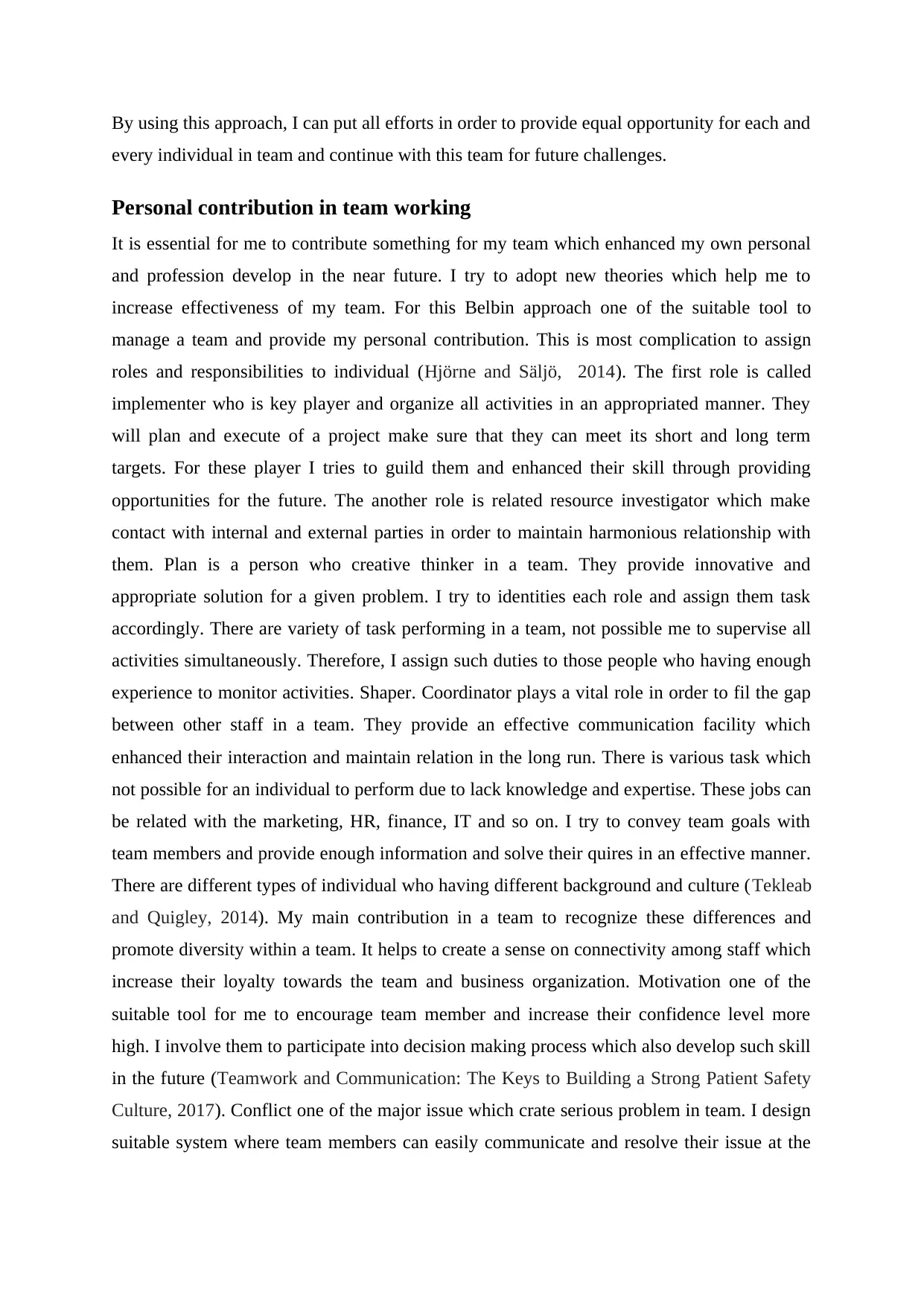
By using this approach, I can put all efforts in order to provide equal opportunity for each and
every individual in team and continue with this team for future challenges.
Personal contribution in team working
It is essential for me to contribute something for my team which enhanced my own personal
and profession develop in the near future. I try to adopt new theories which help me to
increase effectiveness of my team. For this Belbin approach one of the suitable tool to
manage a team and provide my personal contribution. This is most complication to assign
roles and responsibilities to individual (Hjörne and Säljö, 2014). The first role is called
implementer who is key player and organize all activities in an appropriated manner. They
will plan and execute of a project make sure that they can meet its short and long term
targets. For these player I tries to guild them and enhanced their skill through providing
opportunities for the future. The another role is related resource investigator which make
contact with internal and external parties in order to maintain harmonious relationship with
them. Plan is a person who creative thinker in a team. They provide innovative and
appropriate solution for a given problem. I try to identities each role and assign them task
accordingly. There are variety of task performing in a team, not possible me to supervise all
activities simultaneously. Therefore, I assign such duties to those people who having enough
experience to monitor activities. Shaper. Coordinator plays a vital role in order to fil the gap
between other staff in a team. They provide an effective communication facility which
enhanced their interaction and maintain relation in the long run. There is various task which
not possible for an individual to perform due to lack knowledge and expertise. These jobs can
be related with the marketing, HR, finance, IT and so on. I try to convey team goals with
team members and provide enough information and solve their quires in an effective manner.
There are different types of individual who having different background and culture (Tekleab
and Quigley, 2014). My main contribution in a team to recognize these differences and
promote diversity within a team. It helps to create a sense on connectivity among staff which
increase their loyalty towards the team and business organization. Motivation one of the
suitable tool for me to encourage team member and increase their confidence level more
high. I involve them to participate into decision making process which also develop such skill
in the future (Teamwork and Communication: The Keys to Building a Strong Patient Safety
Culture, 2017). Conflict one of the major issue which crate serious problem in team. I design
suitable system where team members can easily communicate and resolve their issue at the
every individual in team and continue with this team for future challenges.
Personal contribution in team working
It is essential for me to contribute something for my team which enhanced my own personal
and profession develop in the near future. I try to adopt new theories which help me to
increase effectiveness of my team. For this Belbin approach one of the suitable tool to
manage a team and provide my personal contribution. This is most complication to assign
roles and responsibilities to individual (Hjörne and Säljö, 2014). The first role is called
implementer who is key player and organize all activities in an appropriated manner. They
will plan and execute of a project make sure that they can meet its short and long term
targets. For these player I tries to guild them and enhanced their skill through providing
opportunities for the future. The another role is related resource investigator which make
contact with internal and external parties in order to maintain harmonious relationship with
them. Plan is a person who creative thinker in a team. They provide innovative and
appropriate solution for a given problem. I try to identities each role and assign them task
accordingly. There are variety of task performing in a team, not possible me to supervise all
activities simultaneously. Therefore, I assign such duties to those people who having enough
experience to monitor activities. Shaper. Coordinator plays a vital role in order to fil the gap
between other staff in a team. They provide an effective communication facility which
enhanced their interaction and maintain relation in the long run. There is various task which
not possible for an individual to perform due to lack knowledge and expertise. These jobs can
be related with the marketing, HR, finance, IT and so on. I try to convey team goals with
team members and provide enough information and solve their quires in an effective manner.
There are different types of individual who having different background and culture (Tekleab
and Quigley, 2014). My main contribution in a team to recognize these differences and
promote diversity within a team. It helps to create a sense on connectivity among staff which
increase their loyalty towards the team and business organization. Motivation one of the
suitable tool for me to encourage team member and increase their confidence level more
high. I involve them to participate into decision making process which also develop such skill
in the future (Teamwork and Communication: The Keys to Building a Strong Patient Safety
Culture, 2017). Conflict one of the major issue which crate serious problem in team. I design
suitable system where team members can easily communicate and resolve their issue at the
⊘ This is a preview!⊘
Do you want full access?
Subscribe today to unlock all pages.

Trusted by 1+ million students worldwide
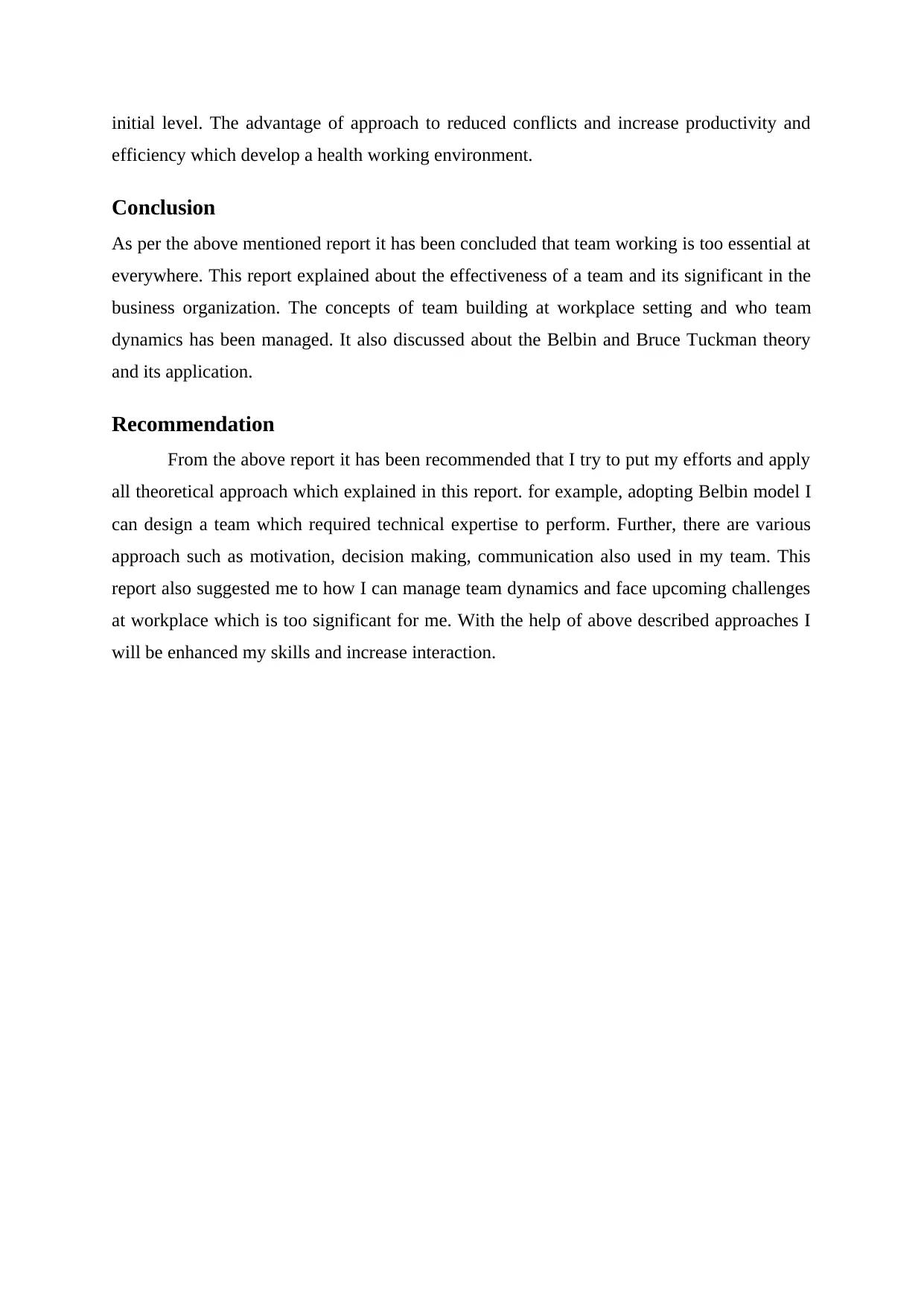
initial level. The advantage of approach to reduced conflicts and increase productivity and
efficiency which develop a health working environment.
Conclusion
As per the above mentioned report it has been concluded that team working is too essential at
everywhere. This report explained about the effectiveness of a team and its significant in the
business organization. The concepts of team building at workplace setting and who team
dynamics has been managed. It also discussed about the Belbin and Bruce Tuckman theory
and its application.
Recommendation
From the above report it has been recommended that I try to put my efforts and apply
all theoretical approach which explained in this report. for example, adopting Belbin model I
can design a team which required technical expertise to perform. Further, there are various
approach such as motivation, decision making, communication also used in my team. This
report also suggested me to how I can manage team dynamics and face upcoming challenges
at workplace which is too significant for me. With the help of above described approaches I
will be enhanced my skills and increase interaction.
efficiency which develop a health working environment.
Conclusion
As per the above mentioned report it has been concluded that team working is too essential at
everywhere. This report explained about the effectiveness of a team and its significant in the
business organization. The concepts of team building at workplace setting and who team
dynamics has been managed. It also discussed about the Belbin and Bruce Tuckman theory
and its application.
Recommendation
From the above report it has been recommended that I try to put my efforts and apply
all theoretical approach which explained in this report. for example, adopting Belbin model I
can design a team which required technical expertise to perform. Further, there are various
approach such as motivation, decision making, communication also used in my team. This
report also suggested me to how I can manage team dynamics and face upcoming challenges
at workplace which is too significant for me. With the help of above described approaches I
will be enhanced my skills and increase interaction.
Paraphrase This Document
Need a fresh take? Get an instant paraphrase of this document with our AI Paraphraser
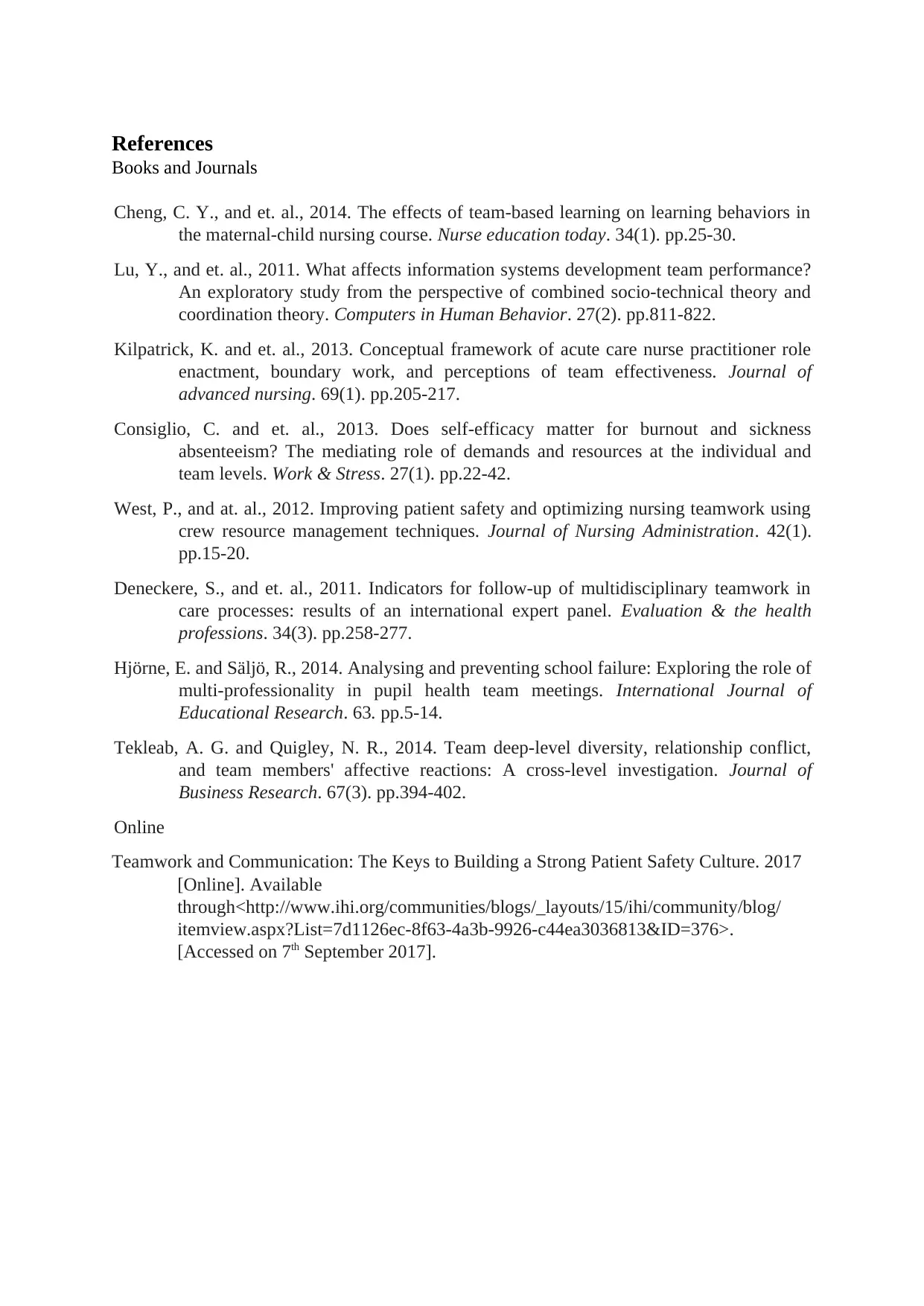
References
Books and Journals
Cheng, C. Y., and et. al., 2014. The effects of team-based learning on learning behaviors in
the maternal-child nursing course. Nurse education today. 34(1). pp.25-30.
Lu, Y., and et. al., 2011. What affects information systems development team performance?
An exploratory study from the perspective of combined socio-technical theory and
coordination theory. Computers in Human Behavior. 27(2). pp.811-822.
Kilpatrick, K. and et. al., 2013. Conceptual framework of acute care nurse practitioner role
enactment, boundary work, and perceptions of team effectiveness. Journal of
advanced nursing. 69(1). pp.205-217.
Consiglio, C. and et. al., 2013. Does self-efficacy matter for burnout and sickness
absenteeism? The mediating role of demands and resources at the individual and
team levels. Work & Stress. 27(1). pp.22-42.
West, P., and at. al., 2012. Improving patient safety and optimizing nursing teamwork using
crew resource management techniques. Journal of Nursing Administration. 42(1).
pp.15-20.
Deneckere, S., and et. al., 2011. Indicators for follow-up of multidisciplinary teamwork in
care processes: results of an international expert panel. Evaluation & the health
professions. 34(3). pp.258-277.
Hjörne, E. and Säljö, R., 2014. Analysing and preventing school failure: Exploring the role of
multi-professionality in pupil health team meetings. International Journal of
Educational Research. 63. pp.5-14.
Tekleab, A. G. and Quigley, N. R., 2014. Team deep-level diversity, relationship conflict,
and team members' affective reactions: A cross-level investigation. Journal of
Business Research. 67(3). pp.394-402.
Online
Teamwork and Communication: The Keys to Building a Strong Patient Safety Culture. 2017
[Online]. Available
through<http://www.ihi.org/communities/blogs/_layouts/15/ihi/community/blog/
itemview.aspx?List=7d1126ec-8f63-4a3b-9926-c44ea3036813&ID=376>.
[Accessed on 7th September 2017].
Books and Journals
Cheng, C. Y., and et. al., 2014. The effects of team-based learning on learning behaviors in
the maternal-child nursing course. Nurse education today. 34(1). pp.25-30.
Lu, Y., and et. al., 2011. What affects information systems development team performance?
An exploratory study from the perspective of combined socio-technical theory and
coordination theory. Computers in Human Behavior. 27(2). pp.811-822.
Kilpatrick, K. and et. al., 2013. Conceptual framework of acute care nurse practitioner role
enactment, boundary work, and perceptions of team effectiveness. Journal of
advanced nursing. 69(1). pp.205-217.
Consiglio, C. and et. al., 2013. Does self-efficacy matter for burnout and sickness
absenteeism? The mediating role of demands and resources at the individual and
team levels. Work & Stress. 27(1). pp.22-42.
West, P., and at. al., 2012. Improving patient safety and optimizing nursing teamwork using
crew resource management techniques. Journal of Nursing Administration. 42(1).
pp.15-20.
Deneckere, S., and et. al., 2011. Indicators for follow-up of multidisciplinary teamwork in
care processes: results of an international expert panel. Evaluation & the health
professions. 34(3). pp.258-277.
Hjörne, E. and Säljö, R., 2014. Analysing and preventing school failure: Exploring the role of
multi-professionality in pupil health team meetings. International Journal of
Educational Research. 63. pp.5-14.
Tekleab, A. G. and Quigley, N. R., 2014. Team deep-level diversity, relationship conflict,
and team members' affective reactions: A cross-level investigation. Journal of
Business Research. 67(3). pp.394-402.
Online
Teamwork and Communication: The Keys to Building a Strong Patient Safety Culture. 2017
[Online]. Available
through<http://www.ihi.org/communities/blogs/_layouts/15/ihi/community/blog/
itemview.aspx?List=7d1126ec-8f63-4a3b-9926-c44ea3036813&ID=376>.
[Accessed on 7th September 2017].
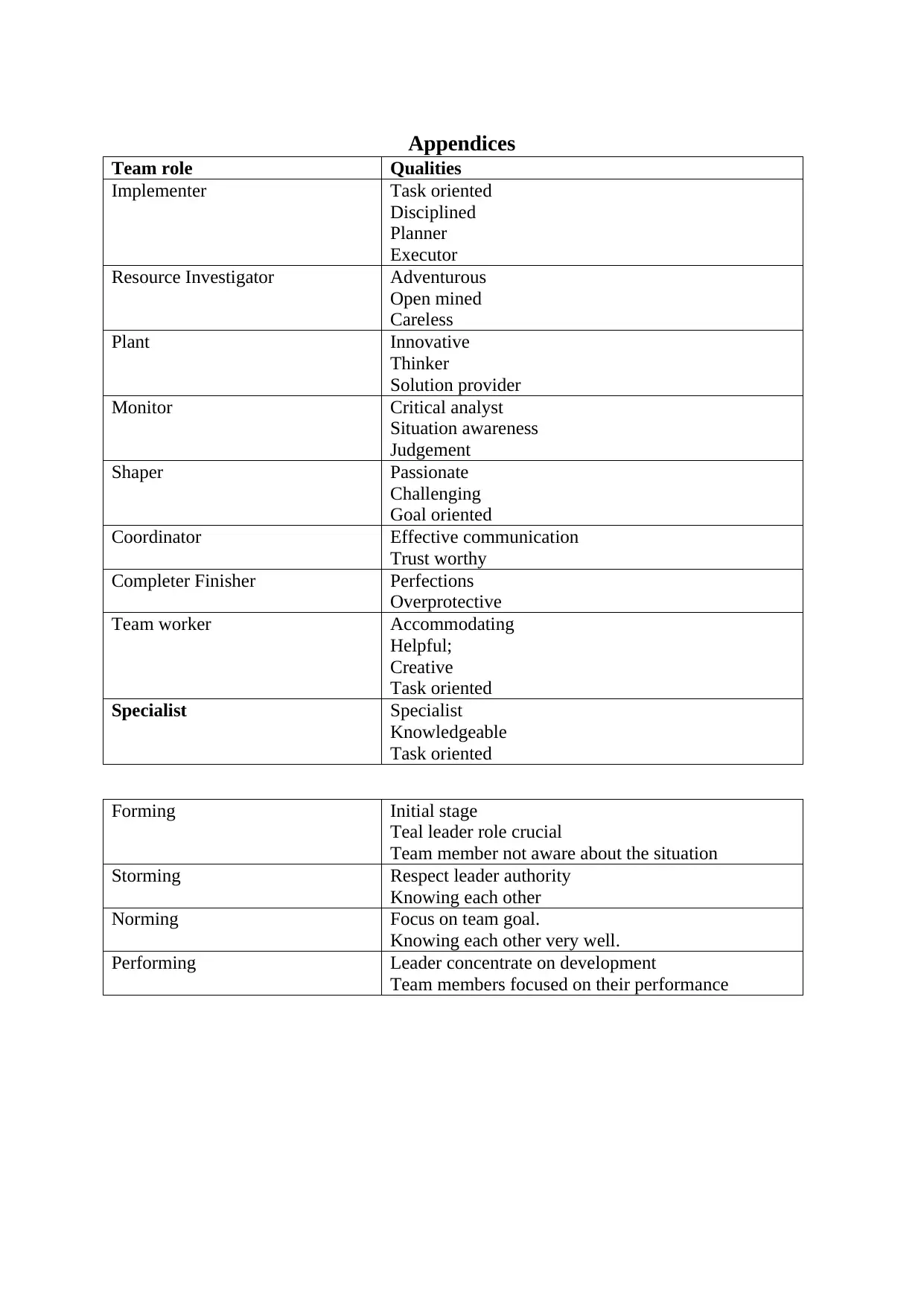
Appendices
Team role Qualities
Implementer Task oriented
Disciplined
Planner
Executor
Resource Investigator Adventurous
Open mined
Careless
Plant Innovative
Thinker
Solution provider
Monitor Critical analyst
Situation awareness
Judgement
Shaper Passionate
Challenging
Goal oriented
Coordinator Effective communication
Trust worthy
Completer Finisher Perfections
Overprotective
Team worker Accommodating
Helpful;
Creative
Task oriented
Specialist Specialist
Knowledgeable
Task oriented
Forming Initial stage
Teal leader role crucial
Team member not aware about the situation
Storming Respect leader authority
Knowing each other
Norming Focus on team goal.
Knowing each other very well.
Performing Leader concentrate on development
Team members focused on their performance
Team role Qualities
Implementer Task oriented
Disciplined
Planner
Executor
Resource Investigator Adventurous
Open mined
Careless
Plant Innovative
Thinker
Solution provider
Monitor Critical analyst
Situation awareness
Judgement
Shaper Passionate
Challenging
Goal oriented
Coordinator Effective communication
Trust worthy
Completer Finisher Perfections
Overprotective
Team worker Accommodating
Helpful;
Creative
Task oriented
Specialist Specialist
Knowledgeable
Task oriented
Forming Initial stage
Teal leader role crucial
Team member not aware about the situation
Storming Respect leader authority
Knowing each other
Norming Focus on team goal.
Knowing each other very well.
Performing Leader concentrate on development
Team members focused on their performance
⊘ This is a preview!⊘
Do you want full access?
Subscribe today to unlock all pages.

Trusted by 1+ million students worldwide

1 out of 10
Related Documents
Your All-in-One AI-Powered Toolkit for Academic Success.
+13062052269
info@desklib.com
Available 24*7 on WhatsApp / Email
![[object Object]](/_next/static/media/star-bottom.7253800d.svg)
Unlock your academic potential
Copyright © 2020–2025 A2Z Services. All Rights Reserved. Developed and managed by ZUCOL.




